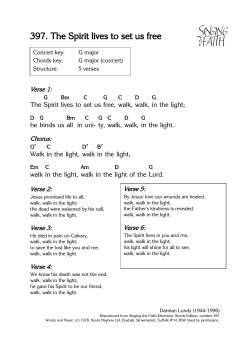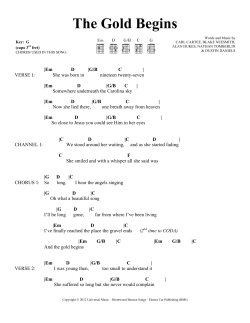
Document 433437
G C S E E D E X C E L M U S I C – S E T W O R K S U M M A R I E S S W R A 1 SET WORK SUMMARY Skye Waulking Song from the album Nàdurra - Capercaillie PART 1 - Placing the Set Work in its Musical, Social and Historical Context “Waulking” is an ancient Scottish process used for making tweed fabric more flexible and windproof. A “Waulking” song refers to a song used to make this process into a more sociable occasion. To keep everyone IN TIME, the work was accompanied by song. There would be one person leading with lyrics, based on a well-known story and others would join in after each line with some NONSENSE SYLLABLES, called VOCABLES. It was considered unlucky to repeat a whole verse, so the songs often had many verses. Technology has now replaced the need of manual “Waulking” by the hands or feet, but the tradition still continues in some parts of Scotland and “Walking songs” are still sung by these societies and collections of “Waulking” songs have been produced in notation and recordings. About the Set Work – Placing the Set Work in a Musical Context Capercaillie were formed in the early 1980’s by Donald Shaw and a few friends. Singer, Karen Matheson joined the band in 1984. The band preserve Scottish Folk Music often singing in SCOTS GAELIC dialect. “Skye Waulking Song” - taken from the album “Nadurra” released in September 2000. The band is made of up 7 members, each with their INDIVIDUAL VIRTUOSITY on their own instruments and their ability to blend together so well in an ensemble The song lyrics tell the tale of Seathan, son of the King of Ireland. The original song (nearly 200 lines long) was a LAMENT sung by Seathan’s wife, telling of his deeds and recollections and is a way of grieving and sharing her feelings of loss. Only a few lines are used in this set work interspersed with VOCABLES (nonsense syllables like “Fa-la-la”) in a CALL AND RESPONSE pattern. The full title for the song, as recorded by Capercaillie, is 'Chuir M'Athair Mise Dhan Taigh Charraideach' (My father sent me to a house of sorrow). “Skye Waulking Song” is an example of FUSION FOLK MUSIC – features of FOLK MUSIC include: “Music of the People” – performed by lower classes of a society expressing something about their way of life, how they used to live, or about local mythology Passed on by the ORAL TRADITION and rarely notated, often performed at INFORMAL occasions such as jam sessions at pubs of social gatherings. Folk Music is about everyone taking part, enjoying the music and passing on tales of life, legend and heritage. Folk Music also popular in the US where BOB DYLAN wrote songs in a folk style but with political lyrics – PROTEST SONGS Folk Music is traditionally played on ACOUSTIC INSTRUMENTS – accordion, bagpipes, banjo, bodhran, bouzouki, concertina, double bass, fiddle, guitar, harmonica, hurdy-gurdy, mandolin, piano, tin/penny whistle, uileann pipes. Electric Instruments such as the bass, keyboard and electric guitar have been used in folk music but some purists feel this isn’t traditional. FUSION is a combining of more than one musical style or culture. Capercaillie are an example of a band that FUSE CELTIC FOLK MUSIC with the instruments and production values of WESTERN POPULAR MUSIC PART 2 – Musical Elements, Instrumentation & Musical Features Time Signature Tempo Slow and calm Tonality The vocal part is sung using the scale of E MINOR PENTATONIC (or G major pentatonic) throughout Harmony Rhythm The harmony is very SIMPLE using only FOUR CHORDS in the whole song. The changes in CHORD SEQUENCE highlight a change of section or mood. The intro established the chord sequence Em-G This changes to C-G-Em-G in Verse 4 adding some harmonic interest In verse 7, the chord sequence changes to Am7-Em-Em-G for one verse only returning to C-G-Em-C in verse 8 and alternating C-G chords in the outro The shaker and hi-hat play every two beats giving the rhythm a TRIPLE feel. The vocal part has a characteristic LILTING rhythm The second and fifth beats of the bar are emphasised by the accordion in the instrumental section Dynamics The dynamics build with the texture of the song, dropping considerably in verse 7 leaving room for the intimate vocal sounds A long FADE OUT brings the song to an end Pitch & Melody Melodic lines are played in the FOLK STYLE – instruments IMPROVISE AROUND A MELODY The “Waulking” song tradition can be heard in the use of VOCABLES between each sung line and the repetition of each line of verse Texture HETEROPHONIC TEXTURE is created when instruments perform a very similar melodic line together, but in slightly different ways (Uilleann pipes solo along with the fiddle in the Instrumental) . There are also examples of instruments weaving a complex improvised COUNTERPOINT around the melody and scale (G major) and the vocals improvise in COUTERPOINT during the outro. Backing vocals thicken the texture when they join in vocalising the nonsense syllables in between each line of lyrics (starting in verse 4). Contrasts in texture, such as the UNACCOMPANIED last line of verse 3 serve as a link between sections and all instruments drop out of the last line of verse 7 similarly. The instruments tend to provide an ACCOMPANIMENT TEXTURE to the vocal parts but instruments (such as the accordion in verse 4) provide a COUNTER MELODY to the vocals Form & Structure INTRO VERSE 5 VERSE 1 VERSE 6 BREAK INSTRUMENTAL VERSE 2 VERSE 7 VERSE 3 VERSE 8 VERSE 4 OUTRO Instrumentation Donald Shaw: accordion, piano, synth; Michael McGoldrick: flutes, whistle, uilleann pipes; Karen Matheson: vocals; Ewen Vernal: acoustic and electric bass; Charlie McKerron: fiddle; Manus Lunny: bouzouki, guitar, bodhran, vocals; James MacKintosh: drums and percussion W W W . M U S I C A L C O N T E X T S , C O . U K
© Copyright 2025









